

| MY
RIG(S) |
|
For a Complete List of Guitars click Here as I'm probably best known as a guitarist...but I play guitar, bass, keyboard, and am currently learning to play drums (albeit very slowly, sometimes to have that time I had as a teenager or twenty-something again).
So to discuss what I use to create music is kind of a gigantic task. For starters, I'm a rampant tinkerer, so I'm always messing with different DAWs, Plugins, Software Instruments, Synths, Guitars, Basses, Pedals, and even my own home-made electronics (which you'll find all over the site). 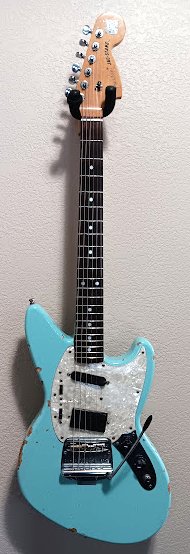
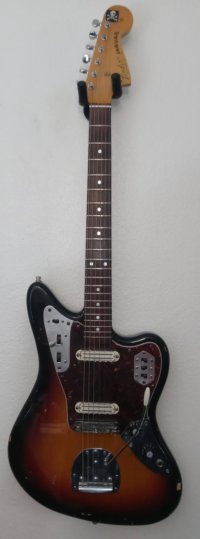
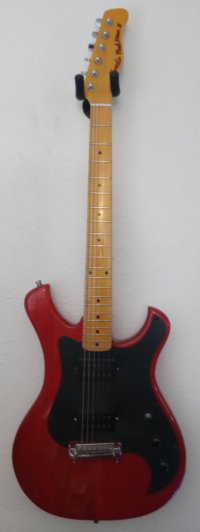


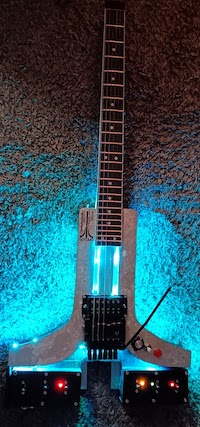
Guitar& Basses - I tend to prefer Fender Offset style axes the most, though I also have a liking for old Kramer superstrats and am a big fan of Paul Dean's (Loverboy) Odyssey/Hondo models, though I only own one (though I have a second home-built one with P-90s in the works). I mostly either buy guitars (often broken) cheap and modify them, or I build my own using a mix of parts and custom carpentry.
Home Studio Setup 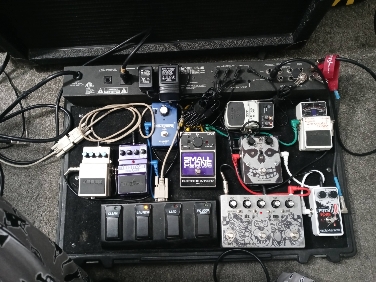
For the Home Studio, my pedalboard acts as the main center of operations. This redesign was a way to reduce waste, embrace digital music technology. The board connects to my Linux machines using USB, and acts as a audio interface through the Line6 HD500. In Studio mode I'm running it in "ABCD" Mode for patches (as opposed to "pedalboard mode") and using the modeling engine. I prefer the HD500 for studio use because it's better supported in hardware as an audio device by Linux (my Katana has an odd behavior of recording the clean guitar input before the effects and amp for some reason unless I use a audio patch panel). All programming is done in a Windows XP/7 virtual machine(s) using the origina Line6 Software, or in my iMac running Mac OSX....depending where in the house I happen to be when programming or recording. On the board, the guitar goes through my custom home-built Skull Fuzz (far right, bottom row), then the Fazz Fuzz (the first pedal I ever built in 2017), then the BOSS SY-1, and then the Electro Harmonix Pitchfork - before being sent to the Line6. Polyphonic Synths are done using the SY-1, while monophonic synths are done using the built-in "Filter" synths on the HD500. This gives me ultimate flexibility overall. I have 4 "setlists" of patches setup for the "Studio" use which include some pretty snappy remakes of some of my old presets (the "voices" from Lithium's Crystal - albeit a new modified version that offers more control, as well as the "least ignored" patch is back as well), as well as some new sounds that are unique and exploit and make good use of the features the HD500 uses, as well as replacements for my Behringer DSP2024P Virtualizer Pro. The board itself is a Livewire PB500 "Arena" board with the bottom row set flat, and the upper two at an angle for the HD500. Live Setup For live, I have a "scalar" setup - where I can basically run the board as I woudl at home in my home studio direct into the soundboard and let the soundman direct the signal (allowing for more stage space), all the way up to running a halfstack with the Katana in 100w mode, and my Peavey 412M Cabinet driving the 4x12 in mono mode, using a traditional mic'd up setup like I would have back in the days of my previous bands. This gives me flexibility and consistant sound across the board. The HD500 controls the Katana over MIDI. When running the halfstack, I'm using a Boss Katana MkII 100watt head with custom patches designed to sound as close to my old Bugera 333XL as possible, but with the EQ's bumped to make up for some of the sonic character that the Bugera lacked (like a chunkier Low-end). I now have basically 4 channels, clean, crunch, lead, and I am still experimenting with the 4th channel. My current strategy involves using the second bank of channels under CC#83 over MIDI which for some reason doesn't activate the "lead" setting, but rather, switches to a variation on the 2nd bank of channels - so that's what I'm using. The HD500 controls the Katana over MIDI, while acting as my "Pedalboard" for the majority of the effects in "Pedalboard/Performance Mode", where now all eight push buttons are open, the bottom 4 acting as my Katana's footswitch, the top 4 + expression acting as my pedals. This allows me to have 64 different "Pedalboards" when playing a live show, and gives me ultimate flexibility when using the halfstack. Other little Details For accessories, I use Dunlop Jazz-series picks, more recently favoring the while "XL" Variety, but I use all the other versions as well. I like these because somehow I get the best "precise" picking with these. For strings, all of my guitars are strung up with Ernie Ball Paradigm .009-.042 gauge strings, even my DG-04 Acoustic guitar (to save stress on the neck), and with the exceptions being the Harmony Nylong String, which uses D'adddario Light nylon strings, and the Bass VI which runs Fender Bass VI Super 250's (the set with the .100 gauge Low E string). The 100 gauge low E on the VI is CRUCIAL because I tune the VI the same as my guitars, just one octave lower, so that means the VI goes into Drop-D and CGDGBE tuning as well. I need that thick low E string to keep it in tune and provide a strong enough magnetic disturbance for the low "D"/"C" string to register enough to count in drop-tunings. My guitars all get frets leveled and recrowned by me, as well as the intonation, and action. I usually run between 1.0-1.5mm at the 12th fret on ALL of my guitars, even teh acoustics, as I favor the action very low so I can play super fast and effortlessly, though I tend to let the guitar guide me on what it likes being setup like. Some of the curvier fretboards might go slightly aboe that spec, maybe 1.75mm, or however high it needs to go to not choke on big, wide bends, and be able to do a crazy John Sykes-like vibrato. I usually do Guitar Honey on the fretboard once a year to keep the rosewood/pau ferro/alternative fretboards happy. My Floyds are usually setup to float, the Mustangs are all setup like my offset guide, though more recently Jaguars and Jazzmasters are getting my "razorblade" mod done to the pivot plate so the whammy is really precise on those and comes to zero effortlessly (as well as giving me the ability to do the "Brad Gillis" cricket thing on a floating trem). All instruments are used with various straps, usually my very old Leopard and Zebra print get'm'get'm' straps, but I have a bunch of others from Fender/Levis/etc. These are attached with Schaller strap-locks on all of my guitars. Live I use Monster Cables, in the studio I just use whatever is around, including home-built stuff. My Monster Cables are the same ones I've been using since 2008 in Smokin' 66, and I have yet to break any of them except the cabinet cable - which ahs been replaced with a home-built replacement with right-angle plugs. I use a Gator dual gig bag for gigging, though some of my guitars have their OHSC still. The Pedalboard has it's own case, which is a vast improvement over the SKB PS-45 I was using before because I now have a shoulder strap, which lightens the load, and makes shows with no backline a breeze since I can just carry everything into the venue in one trip. |